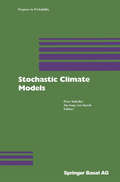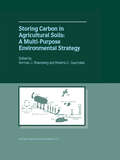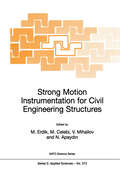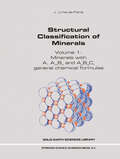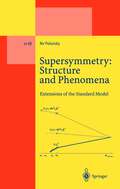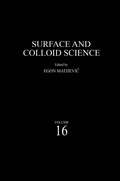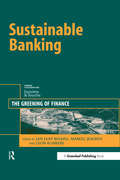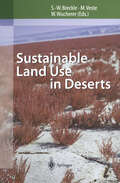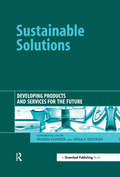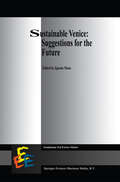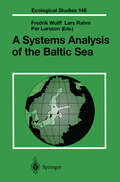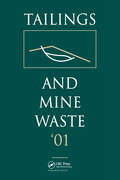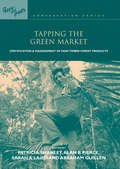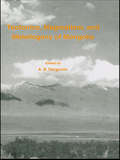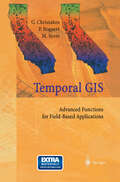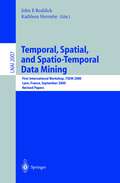- Table View
- List View
Stochastic Analysis and Mathematical Physics (Progress in Probability #50)
by A. B. Cruzeiro J. C. ZambriniThis volume represents the outgrowth of an ongoing workshop on stochastic analysis held in Lisbon. The nine survey articles in the volume extend concepts from classical probability and stochastic processes to a number of areas of mathematical physics. It is a good reference text for researchers and advanced students in the fields of probability, stochastic processes, analysis, geometry, mathematical physics, and physics. Key topics covered include: nonlinear stochastic wave equations, completely positive maps, Mehler-type semigroups on Hilbert spaces, entropic projections, and many others.
Stochastic Climate Models (Progress in Probability #49)
by Peter Imkeller Jin-Song Von StorchA collection of articles written by mathematicians and physicists, designed to describe the state of the art in climate models with stochastic input. Mathematicians will benefit from a survey of simple models, while physicists will encounter mathematically relevant techniques at work.
Storing Carbon in Agricultural Soils: A Multi-Purpose Environmental Strategy
by Roberto C. Izaurralde Norman J. RosenbergSoil carbon sequestration can play a strategic role in controlling the increase of CO2 in the atmosphere and thereby help mitigate climatic change. There are scientific opportunities to increase the capacity of soils to store carbon and remove it from circulation for longer periods of time. The vast areas of degraded and desertified lands throughout the world offer great potential for the sequestration of very large quantities of carbon. If credits are to be bought and sold for carbon storage, quick and inexpensive instruments and methods will be needed to monitor and verify that carbon is actually being added and maintained in soils. Large-scale soil carbon sequestration projects pose economic and social problems that need to be explored. This book focuses on scientific and implementation issues that need to be addressed in order to advance the discipline of carbon sequestration from theory to reality. The main issues discussed in the book are broad and cover aspects of basic science, monitoring, and implementation. The opportunity to restore productivity of degraded lands through carbon sequestration is examined in detail. This book will be of special interest to professionals in agronomy, soil science, and climatology.
Strong Motion Instrumentation for Civil Engineering Structures (NATO Science Series E: #373)
by Mustafa Özder Erdik Mehmet Çelebi Vladimir Mihailov Nurdan ApaydinMost of the existing strong motion instrumentation on civil engineering structures is installed and operated as federal, state, university, industry or private applications, in many cases operated as a closed system. This hampers co-operation and data exchange, hampering the acquisition of strong motion and structural data, sometimes even within a single country. There is a powerful need to inform engineers of existing strong motion data and to improve the accessibility of data worldwide. This book will play a role in fulfilling such a need by disseminating state-of-the art information, technology and developments in the strong motion instrumentation of civil engineering structures. The subject has direct implications for the earthquake response of structures, improvements in design for earthquake resistance, and hazard mitigation. Readership: Researchers in earthquake engineering, engineers designing earthquake resistant structures, and producers of strong motion recording equipment.
Structural Classification of Minerals: Volume I: Minerals with A, Am Bn and ApBqCr General Chemical Formulas (Solid Earth Sciences Library #11)
by J. Lima-de-FariaIn his foreword to Structural Mineralogy. An classification was taken into account. The first Introduction (Lima-de-Faria, 1994) P.B. Moore classification of this type, which takes into con emphasized that this book "is really not an end in sideration the distribution of bonds in a structure, itself. Rather it is a rallying call to urge further was that of silicates proposed by Machatschki clarification, representation and systematization (1928) and developed by Bragg (1930) and Naray of already known structures". If we consider the Szabo (1930). new book by Lima-de-Faria, Structural Classi The pure structural classification of minerals fication of Minerals, in this context, we can ask was first proposed by J. Lima-de-Faria in 1983. It corresponds to the application of the general what kind of new mineralogical data it contains. The twentieth century was characterized by structural classification of inorganic compounds great progress in the study of minerals. Less than (Lima-de-Faria & Figueiredo, 1976) to minerals, 100 minerals were known up until 1800. Since that which are an integral part of them. The most time, the rate of discovery of new minerals is general approach of the structural systematics is steadily increasing. Now it is found that natural based on the analysis of the strength distribution processes select some 4000 mineral species, and and of the directional character of the bonds in this number is increasing by 50-60 minerals every crystal structures.
Studium der Umweltwissenschaften: Rechtswissenschaften (Studium der Umweltwissenschaften)
by Edmund BrandtSupersymmetry: Extensions of the Standard Model (Lecture Notes in Physics Monographs #68)
by Nir PolonskySurface and Colloid Science (Surface and Colloid Science #16)
by Egon MatijevicThe three sections of this volume deal with topics of broad interest. The first deals with cetyl alcohol and is a most comprehensive study of this essential ingredient in the cosmetic and pharmaceutical industry, with an explanation of its functionality. The second is a most comprehensive, up-to-date review of acid/base interactions of a variety of materials, including small molecules, proteins and polyelectrolytes. The third section describes the combined radiochemical and electrochemical methods in the evaluation of the properties of solids in contact with solutions.
Sustainable Banking: The Greening of Finance
by Jan Jaap Bouma Marcel Jeucken Leon KlinkersThis comprehensive addition to the debate on sustainable development has been produced in order to take a global pulse on how the financial services sector is responding to the growing challenge of shareholder and stakeholder expectations on social and environmental performance. In the opinion of many commentators in this new book, given the intermediary role banks play within economies, their potential contribution toward sustainable development is enormous. Indeed, for banks, the conclusion that corporate sustainability has become an investable concept that increases long-term shareholder value is becoming difficult to deny.To date, banks have been relatively slow to examine their exposure to risk (the environmental and social performance of their clients) and the business opportunities of sustainable development (the products and services they offer). Not before time, Sustainable Banking concludes that this is beginning to change, with both risk and opportunity becoming established elements in banking policies towards environmental sustainability. In addition, banks have now begun to take notice of and address their own environmental performance. Through the use of case studies and detailed analysis, the book examines the environmental policies of banks, the importance of transparency and communication with their stakeholders, environmental and ethical investment funds, current practice by the providers of financial services with regard to environmental risk management and, finally, the key role of government, NGOs and multilateral banks in delivering sustainability.Sustainable banking has not, however, been achieved and nor will it be in the immediate future. As globalisation proceeds apace, Sustainable Banking argues that improvements are necessary in banks' attitudes toward transparency and accountability with regard to their lending policies. In addition, in order to promote best practice, the leading banks need to start measuring their customers' environmental performance in order to persuade polluting clients that minimum compliance to regulations will no longer suffice. The book finds many shining examples in the co-operative, mutual and social sectors for the big players to emulate. Environmental and ethical considerations in such loan portfolios have proven to be profitable and "best-in-class" larger banks are now also reaping benefits.The unprecedented scope of the book has attracted contributors from four continents including Deloitte & Touche, Rabobank, The World Bank, The European Bank for Reconstruction and Development, The United Nations Environment Programme, The World Business Council for Sustainable Development, UBS, Henderson Investors, KPMG, The World Resources Institute and SAM Sustainability.
Sustainable Banking: The Greening of Finance
by Jan Jaap Bouma Marcel Jeucken Leon KlinkersThis comprehensive addition to the debate on sustainable development has been produced in order to take a global pulse on how the financial services sector is responding to the growing challenge of shareholder and stakeholder expectations on social and environmental performance. In the opinion of many commentators in this new book, given the intermediary role banks play within economies, their potential contribution toward sustainable development is enormous. Indeed, for banks, the conclusion that corporate sustainability has become an investable concept that increases long-term shareholder value is becoming difficult to deny.To date, banks have been relatively slow to examine their exposure to risk (the environmental and social performance of their clients) and the business opportunities of sustainable development (the products and services they offer). Not before time, Sustainable Banking concludes that this is beginning to change, with both risk and opportunity becoming established elements in banking policies towards environmental sustainability. In addition, banks have now begun to take notice of and address their own environmental performance. Through the use of case studies and detailed analysis, the book examines the environmental policies of banks, the importance of transparency and communication with their stakeholders, environmental and ethical investment funds, current practice by the providers of financial services with regard to environmental risk management and, finally, the key role of government, NGOs and multilateral banks in delivering sustainability.Sustainable banking has not, however, been achieved and nor will it be in the immediate future. As globalisation proceeds apace, Sustainable Banking argues that improvements are necessary in banks' attitudes toward transparency and accountability with regard to their lending policies. In addition, in order to promote best practice, the leading banks need to start measuring their customers' environmental performance in order to persuade polluting clients that minimum compliance to regulations will no longer suffice. The book finds many shining examples in the co-operative, mutual and social sectors for the big players to emulate. Environmental and ethical considerations in such loan portfolios have proven to be profitable and "best-in-class" larger banks are now also reaping benefits.The unprecedented scope of the book has attracted contributors from four continents including Deloitte & Touche, Rabobank, The World Bank, The European Bank for Reconstruction and Development, The United Nations Environment Programme, The World Business Council for Sustainable Development, UBS, Henderson Investors, KPMG, The World Resources Institute and SAM Sustainability.
Sustainable Land Use in Deserts
by Siegmar-W. Breckle Maik Veste Walter WuchererChanging desert areas for land use implies a lot of ecological problems. These and related ones are dealt with in this book covering various interdisciplinary and international aspects. Large areas in arid and semi-arid regions are already polluted in various ways. One of the biggest problems is the anthropogenic salinization by inadequate means of agriculture and irrigation. Additionally, most arid areas in the world are dramatically overgrazed. Methods and practices of a sustainable land use in deserts are urgently needed in many arid regions. This book gives a broad survey on some of the affected regions of the world as well as some case studies from elsewhere (Aral Sea, Negev desert, Namib desert etc.). Thus, basic and applied sciences are brought together. Water management in deserts, grazing systems or reclamation of desertified areas are among the topics of this book, as well as social and economic aspects.
Sustainable Solutions: Developing Products and Services for the Future
by Martin Charter Ursula TischnerToughening environmental legislation, national and supra-national environmental product policies and growing customer demands are focusing the attention of companies on the environmental and broader social issues linked to the creation and delivery of their products and services. There is now an urgent need for appropriate management structures, practical tools and increased awareness among all stakeholders in the product development process and throughout the entire product life-cycle. These are huge issues – with major implications for corporate management, design and production strategies. Sustainable Solutions provides state-of-the-art analysis and case studies on why and how cutting-edge companies are developing new products and services to fit "triple-bottom-line" expectations. The book is split into three sections: first, the broad issues of business sustainability are examined with focus on sustainable production and consumption and consideration of North–South issues. Second, the book tackles the major methodologies and approaches toward organising and developing more sustainable products and services. Third, an outstanding collection of global case studies highlights the progress made by a wide range of companies toward dematerialisation, eco-innovation and design for durability. Finally, the book collects together a comprehensive list of web addresses of useful organisations. Practical and comprehensive, Sustainable Solutions will be essential reading for corporate managers, product designers, R&D staff, academics and all individuals interested in a definitive source on how new product and service development can and is contributing toward tacking the challenge of sustainable development.
Sustainable Solutions: Developing Products and Services for the Future
by Martin Charter Ursula TischnerToughening environmental legislation, national and supra-national environmental product policies and growing customer demands are focusing the attention of companies on the environmental and broader social issues linked to the creation and delivery of their products and services. There is now an urgent need for appropriate management structures, practical tools and increased awareness among all stakeholders in the product development process and throughout the entire product life-cycle. These are huge issues – with major implications for corporate management, design and production strategies. Sustainable Solutions provides state-of-the-art analysis and case studies on why and how cutting-edge companies are developing new products and services to fit "triple-bottom-line" expectations. The book is split into three sections: first, the broad issues of business sustainability are examined with focus on sustainable production and consumption and consideration of North–South issues. Second, the book tackles the major methodologies and approaches toward organising and developing more sustainable products and services. Third, an outstanding collection of global case studies highlights the progress made by a wide range of companies toward dematerialisation, eco-innovation and design for durability. Finally, the book collects together a comprehensive list of web addresses of useful organisations. Practical and comprehensive, Sustainable Solutions will be essential reading for corporate managers, product designers, R&D staff, academics and all individuals interested in a definitive source on how new product and service development can and is contributing toward tacking the challenge of sustainable development.
Sustainable Venice: Suggestions for the Future (Economics, Energy and Environment #16)
by I. MusuIt is universally recognised that Venice and its lagoon are of such value that they constitute an international public good that must be preserved for humanity as a whole. But such an ambitious task requires a diversified, sustainable set of economic activities, mostly focused on the production of services and non-material goods. This complex issue is analyzed using different approaches, with a discussion of the case of Venice as an example of some of the most relevant problems concerning the relation between the environment and development in the contemporary world: the trade-off between preserving an ecosystem and considering it as an economic resource; the evolution of different urban growth scenarios and the preservation of a physical habitat; the role of immaterial production in urban economic development; the nature of tourism as a sustainable activity, considered from both from the environmental and cultural angles; the institutional aspect of governing a process of sustainable urban development. Readership: A unique resource for environmental and urban managers, policy analysts, students of sustainable development, and anyone else interested in the social and economic implications of preserving one of the most loved and celebrated cities in the world.
Synoptic and Dynamic Climatology
by Roger G. Barry Andrew M. CarletonSynoptic and Dynamic Climatology provides the first comprehensive account of the dynamical behaviour and mechanisms of the global climate system and its components, together with a modern survey of synoptic-scale weather systems in the tropics and extratropics, and of the methods and applications of synoptic climate classification. It is unrivalled in the scope and detail of its contents. The work is thoroughly up to date, with extensive bibliographies by chapter. It is illustrated with nearly 300 figures and plates.*Part 1 provides an introduction to the global climate system and the space-time scales of weather and climate processes, followed by a chapter on climate data and their analysis*Part 2 describes and explains the characteristics of the general circulation of the global atmosphere and includes the nature and causes of global teleconnection patterns*Part 3 discusses synoptic weather systems in the extratropics and tropics and satellite-based climatologies of synoptic features. It also describes the applications of synoptic climatology and summarises current climatic research and its directions.
Synoptic and Dynamic Climatology
by Roger G. Barry Andrew M. CarletonSynoptic and Dynamic Climatology provides the first comprehensive account of the dynamical behaviour and mechanisms of the global climate system and its components, together with a modern survey of synoptic-scale weather systems in the tropics and extratropics, and of the methods and applications of synoptic climate classification. It is unrivalled in the scope and detail of its contents. The work is thoroughly up to date, with extensive bibliographies by chapter. It is illustrated with nearly 300 figures and plates.*Part 1 provides an introduction to the global climate system and the space-time scales of weather and climate processes, followed by a chapter on climate data and their analysis*Part 2 describes and explains the characteristics of the general circulation of the global atmosphere and includes the nature and causes of global teleconnection patterns*Part 3 discusses synoptic weather systems in the extratropics and tropics and satellite-based climatologies of synoptic features. It also describes the applications of synoptic climatology and summarises current climatic research and its directions.
A Systems Analysis of the Baltic Sea (Ecological Studies #148)
by F. V. Wulff L. A. Rahm P. LarssonDuring recent decades, large-scale effects of pollution on marine estuaries and even entire enclosed coastal seas have become apparent. One of the first regions where this was observed is the Baltic Sea, whereby the appearance of anoxic deep basins, extensive algal blooms and elimination of top predators like eagles and seals indicated effects of both increased nutrient inputs and toxic substances.This book describes the physical, biochemical and ecological processes that govern inputs, distribution and ecological effects of nutrients and toxic substances in the Baltic Sea. Extensive reviews are supplemented by budgets and dynamic simulation models.This book is highly interdisciplinary and uses a systems approach for analyzing and describing a marine ecosystem. It gives an overview of the Baltic Sea, but is useful for any marine scientist studying large marine ecosystems.
Tailings and Mine Waste 2001
by A. A. A. A. Balkema PublishersThese papers focus on mine and mill tillings and mine waste. The work also contains information on subjects related to: regulations, technical capacities and developments. This guide identifies the current and future issues facing the mining and enviromental concerns.
Tailings and Mine Waste 2001
by NoneThese papers focus on mine and mill tillings and mine waste. The work also contains information on subjects related to: regulations, technical capacities and developments. This guide identifies the current and future issues facing the mining and enviromental concerns.
Tapping the Green Market: Management and Certification of Non-timber Forest Products
by Abraham Guillen Sarah A Laird Alan R Pierce Patricia ShanleyThere is a rapidly growing interest in, and demand for, non-timber forest products (NTFPs). They provide critical resources across the globe fulfilling nutritional, medicinal, financial and cultural needs. However, they have been largely overlooked in mainstream conservation and forestry politics. This volume explains the use and importance of certification and eco-labelling for guaranteeing best management practices of non-timber forest products in the field. Using extensive case studies and global profiles of non-timber forest products, this work not only seeks to further our comprehension of certification processes but also broaden understanding of non-timber forest product management, harvesting and marketing. It should be useful to forest managers, policy-makers and conservation organizations as well as for academics in these areas.
Tapping the Green Market: Management and Certification of Non-timber Forest Products (People And Plants International Conservation Ser.)
by Patricia Shanley Sarah A Laird Abraham Guillen Alan R PierceThere is a rapidly growing interest in, and demand for, non-timber forest products (NTFPs). They provide critical resources across the globe fulfilling nutritional, medicinal, financial and cultural needs. However, they have been largely overlooked in mainstream conservation and forestry politics. This volume explains the use and importance of certification and eco-labelling for guaranteeing best management practices of non-timber forest products in the field. Using extensive case studies and global profiles of non-timber forest products, this work not only seeks to further our comprehension of certification processes but also broaden understanding of non-timber forest product management, harvesting and marketing. It should be useful to forest managers, policy-makers and conservation organizations as well as for academics in these areas.
Tectonics, Magmatism and Metallogeny of Mongolia
by A. B. DergunovThis volume provides the first systematic description of the most important geological structures of Mongolia and discusses the main features of these structures and their interactions. The main characteristics of magmatism are described for each stage of tectonic development and the evolution of magmatism is considered with reference to lithosphere development. Mongolia is a key region of the world and this volume provides a primary source of reference for postgraduates and researchers.
Tectonics, Magmatism and Metallogeny of Mongolia
by A. B. DergunovThis volume provides the first systematic description of the most important geological structures of Mongolia and discusses the main features of these structures and their interactions. The main characteristics of magmatism are described for each stage of tectonic development and the evolution of magmatism is considered with reference to lithosphere development. Mongolia is a key region of the world and this volume provides a primary source of reference for postgraduates and researchers.
Temporal GIS: Advanced Functions for Field-Based Applications
by George Christakos Patrick Bogaert Marc SerreTemporal, Spatial, and Spatio-Temporal Data Mining: First International Workshop TSDM 2000 Lyon, France, September 12, 2000 Revised Papers (Lecture Notes in Computer Science #2007)
by John F. Roddick Kathleen HornsbyThis volume contains updated versions of the ten papers presented at the First International Workshop on Temporal, Spatial and Spatio-Temporal Data Mining (TSDM 2000) held in conjunction with the 4th European Conference on Prin- ples and Practice of Knowledge Discovery in Databases (PKDD 2000) in Lyons, France in September, 2000. The aim of the workshop was to bring together experts in the analysis of temporal and spatial data mining and knowledge discovery in temporal, spatial or spatio-temporal database systems as well as knowledge engineers and domain experts from allied disciplines. The workshop focused on research and practice of knowledge discovery from datasets containing explicit or implicit temporal, spatial or spatio-temporal information. The ten original papers in this volume represent those accepted by peer review following an international call for papers. All papers submitted were refereed by an international team of data mining researchers listed below. We would like to thank the team for their expert and useful help with this process. Following the workshop, authors were invited to amend their papers to enable the feedback received from the conference to be included in the ?nal papers appearing in this volume. A workshop report was compiled by Kathleen Hornsby which also discusses the panel session that was held.

